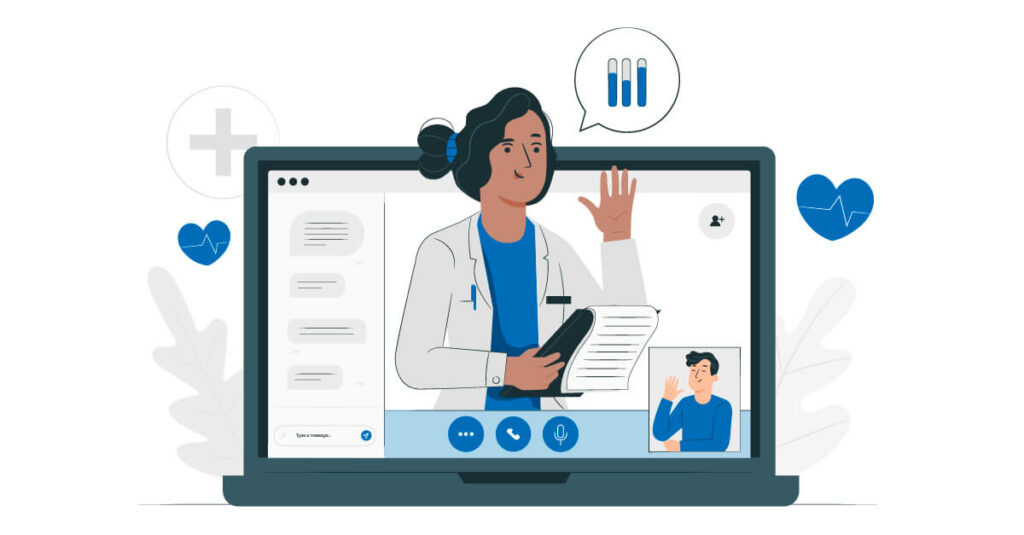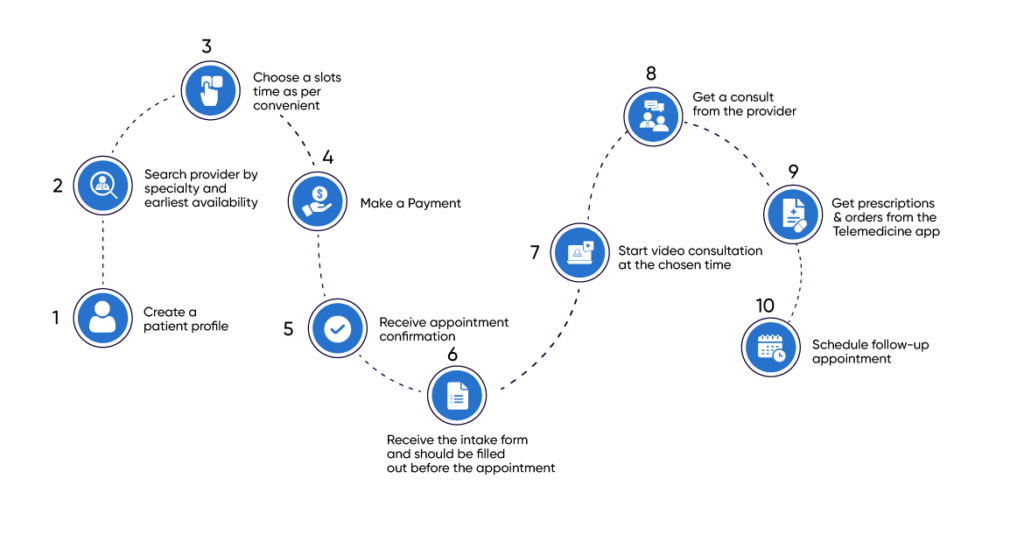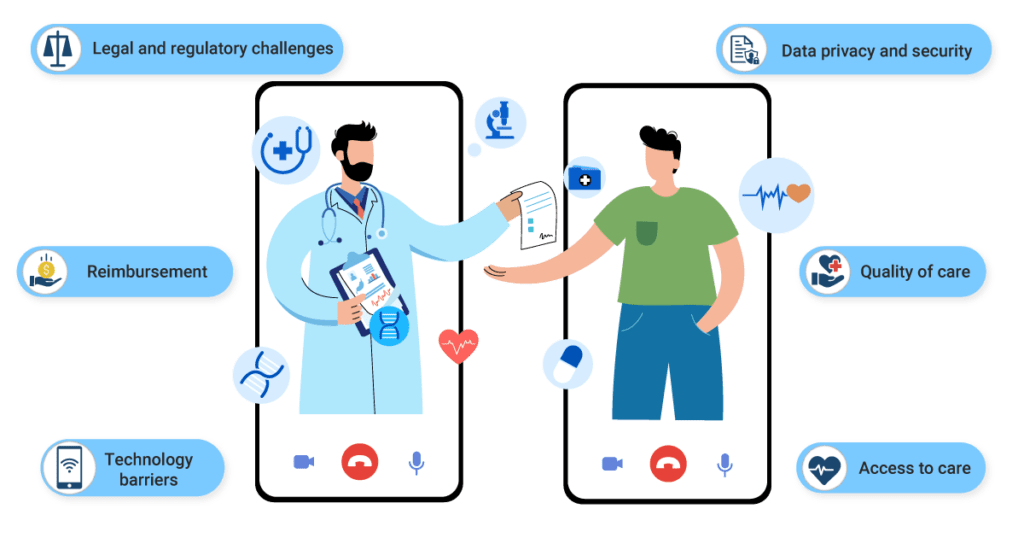What is Telemedicine?
The Covid-19 pandemic compelled healthcare systems to discover alternatives to in-person provider office visits. As a result, They explored telemedicine as a way to reduce the gap between providers and patients.
In this blog, we’ll discuss what telemedicine is, how it works, and the critical differences between telemedicine and telehealth. In addition to that, we will discuss, what are the challenges of telehealth and its future.

Telemedicine is the use of technology to provide medical care and services remotely. It involves using telecommunication and information technologies to diagnose, treat, and monitor patients from a distance. The use of telemedicine has been on the rise in recent years. With the advancements in technology, it is more accessible and convenient for both patients and healthcare providers.
Telemedicine has many advantages. It improves access to healthcare for patients. They can receive medical care from home. It eliminates the need to travel to a hospital.
It can be more convenient for patients with mobility issues or living in remote areas with limited healthcare services. It can reduce administrative burdens for healthcare providers, allowing them to see more patients in less time.
Telemedicine can take several forms, including virtual consultations, remote monitoring, and telemedicine clinics.
Telemedicine clinics include virtual consultations involving a patient communicating with a healthcare provider. It can help people who have difficulty accessing medical services or live in rural areas. It provides improved access to healthcare services providers over video, phone, or text. It can diagnose and treat minor ailments, offer medication management, and provide counseling services.
Remote monitoring involves using technology to track a patient’s health vitals from a distance. It can benefit patients with chronic conditions requiring continuous monitoring, such as diabetes or heart disease.
Advantage of Telemedicine
Telemedicine has several advantages for healthcare providers as well as patients. It can increase efficiency by reducing wait times, allowing providers to see more patients in less time. Costs can be saved by reducing the need for office space and equipment. It also eliminates the need for providers to travel to different locations to see patients.
Difference Between Telemedicine And Telehealth
The significant differences between telemedicine and telehealth.
Telemedicine refers to using electronic communication technologies, such as video conferencing, to provide clinical healthcare services remotely. It is a curative approach, and only authorized persons can treat patients.
It can include consultations, diagnosis, treatment, and monitoring of patients from a distance. Telemedicine is often used for short-term care. Examples include virtual consultations with a provider or specialist and remote patient vital signs monitoring.
On the other hand, telehealth is a broader term encompassing all aspects of healthcare delivered remotely, not just clinical care. Telehealth covers many aspects of healthcare. These include health education, wellness programs, and remote patient monitoring.
It also covers administrative tasks, like scheduling appointments and managing medical records. Telehealth includes telemedicine, which is clinical care. However, telehealth offers much more. It provides a variety of non-clinical services to promote better health outcomes.
Telemedicine is a subset of telehealth. It focuses on providing clinical care remotely.
Telehealth covers a broader range of remote healthcare services. In summary, telemedicine is a subset of telehealth.
How Does Telemedicine Work?

Telemedicine starts with the patient signing up and requesting an appointment through the Telemedicine platform. This appointment is with a provider of the patient’s choice. The patient must provide some basic information, such as their demographic details, Insurance details, and reason for an appointment.
The healthcare provider requires the patient to complete a health assessment before the appointment. They must also provide past medical history information to prepare for the encounter.
Once the patient has scheduled an appointment, they will receive a confirmation message and instructions on connecting with the provider. Before joining the video call, the patient should sign consent. Patients will receive instructions on preparing for the appointment and take vitals such as blood pressure, body temperature, and weight.
During the consultation, the healthcare provider will ask the patient about their symptoms, medical history, and any past medications. The provider also performs a visual examination, depending on the nature of the medical condition.
After the consultation, the provider will create SOAP notes for the patient with a diagnosis (ICD-10), treatment plan, and necessary prescriptions. The provider recommends follow-up appointments or additional tests, depending on the severity of the medical condition.
Benefits of Telemedicine Software
There are numerous benefits of telemedicine software. Let’s discuss telemedicine benefits one by one.
Convenience and Accessibility
It allows patients to access healthcare services from the comfort of their own homes or anywhere. It is especially beneficial for those living in rural areas or with mobility issues. With telemedicine, patients can receive medical advice and treatment without traveling long distances or leaving their homes.
Cost-effective
Telemedicine is usually cheaper than an in-person visit. It eliminates transportation and reduces waiting time and administrative costs. Moreover, it can reduce the burden on emergency rooms and hospitals, thus reducing overall healthcare costs.
Time-Saving
Telemedicine saves time for both patients and providers. Providers no longer need to spend time on administrative tasks. These tasks include filling out intake forms, and assessments, scheduling appointments, and maintaining records.
Improved Health Outcomes
Telemedicine can improve health outcomes by promptly providing patients with healthcare services. It can help prevent chronic conditions from worsening by offering patients regular check-ups and monitoring them at home.
Enhanced Patient Engagement
It enables patients to take a more active role in their healthcare. Patients can access their records from the patient portal and get all clinical and financial information. They can receive timely notifications and reminders. Telemedicine enables patients to communicate with their healthcare providers and receive personalized care.
Reduced Risk of Infection
It helps reduce infection risk by allowing patients to receive healthcare services remotely. It is vital during the COVID-19 pandemic, as it reduces the risk of exposure to the virus.
Where Telemedicine Services Provided
Telemedicine services can be provided from various settings, depending on the specific needs of the patients and the providers. Some of the most common settings where telemedicine services provide include
Hospitals and Clinics
Many hospitals and clinics now offer telemedicine services as part of their standard medical offerings. It allows patients to receive remote consultations with providers and specialists without traveling to a physical location.
Private Practices
Some individual doctors, nurses, and other healthcare professionals offer telemedicine services through their private practices. It is especially beneficial for patients needing a specialist or those living in areas with limited access to healthcare.
Mobile Clinics
Telemedicine services can be provided through mobile clinics or telehealth vans. These vans travel to underserved areas to give medical care to patients who may not have access to traditional healthcare facilities.
Nursing Homes and Long-term Care Facilities
It can provide medical consultations and check-ups for patients in nursing homes and other long-term care facilities. It can reduce the need for transportation and make it easier for patients to receive specialized medical care.
Home-based Care
Telemedicine can be provided directly to patients in their homes. It can be done through remote monitoring devices, video consultations, and other digital communication forms.
Finally, these telehealth services can be accessed from the comfort of one’s home. Patients with mobility issues, chronic conditions, or other health concerns may find this helpful. Traveling to a healthcare facility can be difficult for them.
Challenges of Telemedicine

Telemedicine, the practice of providing healthcare services remotely using technology, has been around for several years. However, the COVID-19 pandemic has accelerated its adoption and usage worldwide. While telemedicine has many advantages, it also poses several challenges that must be addressed to ensure its success.
The challenges of Telemedicine adoption are as follows:
Technology Barriers : One of the most significant challenges of telemedicine is the need for reliable technology infrastructure. Both patients and healthcare providers must have access to high-speed Internet and appropriate devices, such as laptops, tablets, or smartphones. Additionally, the technology used for telemedicine should be user-friendly and reliable.
Data Privacy and Security : Telemedicine involves transmitting sensitive patient information over the Internet, making data privacy and security a significant concern. Healthcare providers must comply with data privacy and security regulations to protect patient data. It includes the US’s HIPAA (Health Insurance Portability and Accountability Act).
Legal and Regulatory Challenges : Telemedicine is rapidly evolving, and the legal and regulatory landscape is still catching up. Regulations for telemedicine differ from state to state and country to country. Healthcare providers must know the legal and regulatory frameworks to offer telemedicine services worldwide.
Access to Care : Telemedicine expands access to healthcare services, particularly for patients living in remote or underserved areas. Telemedicine has the potential to deepen healthcare disparities. Those who have access to or are uncomfortable using the technology may be particularly affected.
Quality of Care : The quality of care provided through telemedicine can vary. Technology, provider experience and training, and the treated health condition affect this. Healthcare providers must ensure that their telemedicine services meet the same standards of care as in-person services.
Reimbursement : Telehealth services are reimbursed at the same rate as in-person services, creating financial challenges for healthcare providers. Additionally, the reimbursement landscape is constantly evolving, and providers must stay updated to ensure appropriate reimbursement for their telehealth services.
Future of Telemedicine
Telemedicine has become more widespread and has changed how healthcare is delivered. Let’s explore the future of telemedicine and its potential impact on healthcare.
- Increased Adoption of Telemedicine
The pandemic has led to an exponential increase in the adoption of telemedicine. Patients have embraced telemedicine as a safe and convenient alternative to in-person visits. Healthcare providers have realized the benefits of telehealth, including increased access to care, reduced healthcare costs, and improved patient outcomes.
- Telemedicine and Chronic Care Management
Telemedicine can improve the management of chronic conditions by allowing patients to connect with their healthcare providers more frequently and conveniently. Patients can use telemedicine to track their symptoms, receive medication management, and monitor their vital signs. This can help prevent hospitalizations and reduce healthcare costs.
- Telemedicine and Mental Health
Telemedicine can help address the shortage of mental health providers by enabling patients to access care remotely. Patients can receive therapy and counseling from the comfort of their own homes. It helps reduce stigma and improve patient outcomes. Telemedicine can also help providers reach patients in rural areas with limited mental health services.
- Telemedicine and Artificial Intelligence
Telemedicine can be enhanced by artificial intelligence (AI) to improve patient outcomes. AI can analyze patient data, including medical records and lab results, to provide more accurate diagnoses and treatment plans. AI can also monitor patients remotely and alert healthcare providers of any concerning changes in their condition.
- Telemedicine and Virtual Reality
Virtual reality (VR) can be used in telemedicine to improve patient engagement and education. VR can provide immersive experiences to help patients better understand their condition and treatment. VR can simulate medical procedures, allowing patients to experience them before undergoing the real thing.
Thinkitive’s Telemedicine Software Solutions
Thinkitive offers telemedicine solutions that enable healthcare providers to deliver remote consultations, diagnoses, and treatments to patients. We provide a secure, easy-to-use telemedicine platform for healthcare providers to connect with patients via video, audio, and messaging tools.
Some of the critical features of Thinkitive’s telemedicine software solutions include:
- Customizable Telemedicine Platforms
Thinkitive offers custom telemedicine software solutions tailored to the specific needs of healthcare providers. Features include appointment scheduling and revenue management.
- Analytics and Reporting
It provides healthcare providers insights into patient engagement, usage patterns, and outcomes.
- Video Conferencing
The most crucial feature of telehealth software is video conferencing, which allows patients and providers to communicate in real-time. Video conferencing enables providers to examine and simultaneously diagnose patients remotely and finally provide them with medical advice and prescriptions.
- Electronic Health Records Integration
The provider can integrate EMR with multiple EHRs. It Will help providers ensure that patient information is accurate, up-to-date, and accessible to healthcare providers. Providers can get patients’ diagnoses and condition details.
- Scheduling and Appointment Reminders:
In the Telemedicine platform, providers and patients can schedule appointments, reschedule and cancel for valid reasons. Patients can get timely reminders and notifications, which helps to cut down on missed appointments.
- Messaging and Chat
Messaging feature allows patients to communicate with their healthcare providers quickly and easily. Patients can ask questions, get clarification on medical advice, or provide updates on their condition.
- Custom Templates
The provider can design SOAP notes, assessments, intake form templates, etc. Before the visit, the provider can email the patient an intake form so they can learn more about their medical history.
Healthcare providers used pre-filled templates during examinations. Custom templates allowed them to reduce the time spent looking at screens. This speed up more time for them to provide care to patients.
- Prescription Management
It assists healthcare providers to manage prescriptions electronically. Providers can review patient medication history, prescribe medications, and send electronic prescriptions directly to the patient’s preferred pharmacy.
- Payment and Billing
Providers can get updated about financial, payment & claim reimbursements. Payment integration enables patients to make payments online. This feature should be easy to use, secure, and compliant with healthcare regulations.
Conclusion
Telemedicine allows patients to access healthcare services from the comfort of their own homes. Telemedicine services can transform the healthcare sector and improve patient outcomes. It is helpful to manage chronic conditions by pushing vitals regularly so providers can understand the patient’s condition.
It is especially beneficial for those living in rural areas or with mobility issues. With telehealth solutions, patients can receive medical advice and treatment without traveling long distances or leaving their homes.
For any questions and inquiries related to Telemedicine software development, we invite you to visit us at Thinkitive.




